Effects of food resources on the fatty acid composition, growth and survival of freshwater mussels
- PMID: 28267810
- PMCID: PMC5340365
- DOI: 10.1371/journal.pone.0173419
Effects of food resources on the fatty acid composition, growth and survival of freshwater mussels
Abstract
Increased nutrient and sediment loading in rivers have caused observable changes in algal community composition, and thereby, altered the quality and quantity of food resources available to native freshwater mussels. Our objective was to characterize the relationship between nutrient conditions and mussel food quality and examine the effects on fatty acid composition, growth and survival of juvenile mussels. Juvenile Lampsilis cardium and L. siliquoidea were deployed in cages for 28 d at four riverine and four lacustrine sites in the lower St. Croix River, Minnesota/Wisconsin, USA. Mussel foot tissue and food resources (four seston fractions and surficial sediment) were analyzed for quantitative fatty acid (FA) composition. Green algae were abundant in riverine sites, whereas cyanobacteria were most abundant in the lacustrine sites. Mussel survival was high (95%) for both species. Lampsilis cardium exhibited lower growth relative to L. siliquoidea (p <0.0001), but growth of L. cardium was not significantly different across sites (p = 0.13). In contrast, growth of L. siliquoidea was significantly greater at the most upstream riverine site compared to the lower three lacustrine sites (p = 0.002). In situ growth of Lampsilis siliquoidea was positively related to volatile solids (10 - 32 μm fraction), total phosphorus (<10 and 10 - 32 μm fractions), and select FA in the seston (docosapentaeonic acid, DPA, 22:5n3; 4,7,10,13,16-docosapentaenoic, 22:5n6; arachidonic acid, ARA, 20:4n6; and 24:0 in the <10 and 10 - 32 μm fractions). Our laboratory feeding experiment also indicated high accumulation ratios for 22:5n3, 22:5n6, and 20:4n6 in mussel tissue relative to supplied algal diet. In contrast, growth of L. siliquiodea was negatively related to nearly all FAs in the largest size fraction (i.e., >63 μm) of seston, including the bacterial FAs, and several of the FAs associated with sediments. Reduced mussel growth was observed in L. siliquoidea when the abundance of cyanobacteria exceeded 9% of the total phytoplankton biovolume. Areas dominated by cyanobacteria may not provide sufficient food quality to promote or sustain mussel growth.
Conflict of interest statement
Figures
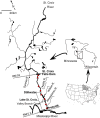

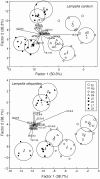
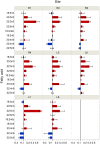


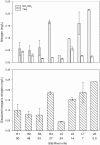


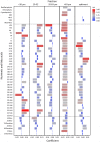

References
-
- Gatenby CM, Parker BC, Neves RJ. Growth and survival of juvenile rainbow mussels, Villosa iris (Lea, 1829) (Bivalvia: Uniondae), reared on algal diets and sediment. Am Malacol Bull. 1997;14: 57 – 66.
-
- Gatenby CM, Neves RJ, Parker BC. Influence of sediment and algal food on cultured juvenile freshwater mussels. J North Am Benthol Soc. 1996;15: 597 – 609.
-
- Nichols SJ, Garling D. Food-web dynamics and trophic-level interactions in a multispecies community of freshwater unionids. Can J Zool. 2000;78: 871 – 882.
-
- Christian AD, Smith BN, Berg DJ, Smoot JC, Findlay RH. Trophic position and potential food sources of 2 species of unionid bivalves (Mollusca: Unionidae) in 2 small Ohio streams. J North Am Benthol Soc. 2004;23: 101 – 113.
-
- Vanderploeg HA, Liebig JR, Nalepa TF. From picoplankton to microplankton: temperature-driven filtration by the unionid bivalve Lampsilis radiata siliquoidea in Lake St. Clair. Can J Fish Aquatic Sci. 1995;52: 63 – 74.
MeSH terms
Substances
LinkOut - more resources
Full Text Sources
Other Literature Sources
Research Materials
Miscellaneous

